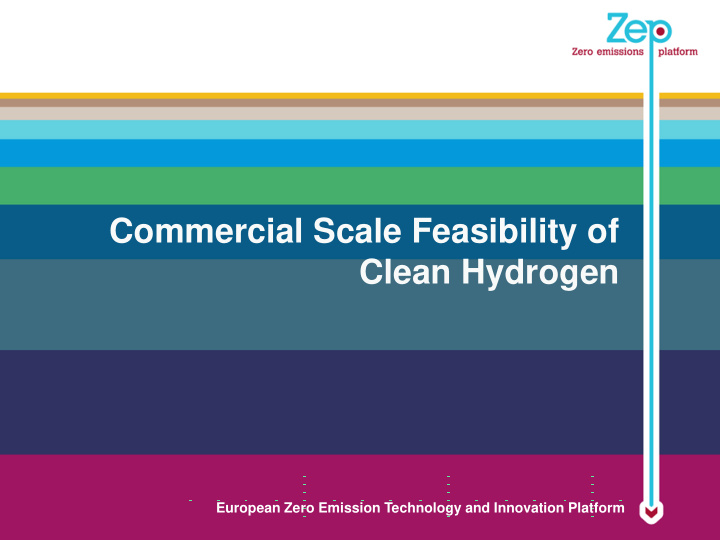



Commercial Scale Feasibility of Clean Hydrogen European Zero Emission Technology and Innovation Platform
Potential hydrogen demand There is significant future potential for both clean (through SMR/ATR of natural gas with CCS) and electrolysis-derived hydrogen – collectively referred to as sustainable hydrogen Cross-sector decarbonisation – applications for: • Transport • Power • Heat • Industry Report recommends maximising cross-cutting opportunities with other initiatives around the world (e.g. USA, UK & Japan) and other EU hydrogen initiatives 2
Sustainable hydrogen applications Examples include: • Buildings (heating and cooling) o Japan: ENE-FARM stationary fuel cells project (>100 000 units installed) • City gas: H21 Leeds City Gate, o UK: technical and economic feasibility for conversion of NG grid to H 2 • Transport: o Japan: aiming at 40 000 H 2 fuel cell vehicles by 2020, o Germany and California: building multiple H 2 fuelling stations • Multiple industrial possibilities: chemicals, refining, steel (often connected to CCU) • Power generation: H 2 -fuelled Combined Cycle Gas Turbines in the future 3
Hydrogen production with CO 2 capture Most mature technology pathway: Steam-methane reforming followed by water- gas shift, CO2 capture and H2 purification with PSA 4
Separation Technologies The challenge: separate CO 2 and H 2 with sufficient purity of both and low energy consumption and cost Absorption Chemical and physical solvents for CO 2 removal are commercial technology in operation as part of a CCS value chain at Quest since 2015 and applied in many existing SMRs. Adsorption A PSA for H 2 purification is commercial technology, A PVSA for CO 2 capture from the syngas is also a commercially available technology as its first plant has been operational in Port Arthur, Texas since 2013. Membranes High-temperature membranes for H 2 separation are widely being investigated and there are also commercial products on the market, but they have not yet reached industrial-scale. Metallic membranes, typically Pd membranes or Pd-alloy membranes theoretically have an infinite selectivity of H 2 , i.e. the ability to produce pure hydrogen. These are progressing towards industrial manufacturing methods and demonstration. Microporous membranes have lower H 2 selectivity but are cheaper and have a higher stability. Cryogenic separation Can produce moderately pure H 2 from syngas. The technology is commercially available but refrigeration demand is high, meaning that it is typically not used as the main separation technology. The main application for cryogenic technology in hydrogen applications is H 2 liquefaction for (long-distance) transport. Low-temperature Used e.g. at the Air Liquide Port Jerome plant. Has also been demonstrated by Tokyo Gas separation of CO 2 or downstream membrane separation of hydrogen in a hydrogen membrane reformer. The principle CO 2 liquefaction is that in a well-designed compression and cooling process, CO 2 condenses and can be separated from lighter gaseous components. 5
Hydrogen plants with CO 2 capture or CCS Port Arthur, Texas, US: • CO 2 capture capacity: 1,000,000 tonnes per year Quest, Alberta, Canada: • CO 2 capture capacity: ~1,000,000 tonnes per year Tomakomai, Japan: • CO 2 capture capacity: 100,000 tonnes per year Port-Jérome, France: • CO 2 capture capacity: 100,000 tonnes per year STEPWISE pilot, Sweden: • CO 2 capture capacity: ~5,000 tonnes per year 6
Comparison of clean hydrogen compared to electrolysis-derived hydrogen from renewables • Current H 2 production is predominantly from natural gas via SMR (Steam-methane reforming) ATR (autothermal reforming) is also proven. • ATR is anticipated to offer lower-cost clean H 2 and higher capacities • Electrolysis-derived hydrogen from renewable energy is anticipated to grow to form a large proportion of the future low-carbon hydrogen mix 7
H 2 production cost: present and future 8
Growing sustainable hydrogen value chains There is a significant potential for hydrogen to contribute to future energy systems: • H 2 for refineries is dominating today • Mobility: growing slowly in Japan, California, Germany, Norway, UK, … • Potential also in industrial and residential use Collaboration is crucial: • Key players along the value chain must be recognized: energy companies, industrial gas suppliers, OEMs for turbines and fuel cells, car manufacturers, customers and governments • All the stakeholders need to be able to recognise the benefit of a new or growing industry for it to be successful • H 2 from natural gas without CCS will have a lower production cost than with CCS or from electrolysis with renewables • The value of decarbonisation must be recogniised: o The positive impacts must be valorized o A market mechanism is required for developing a clean + renewable hydrogen economy o Long-term regulatory consistency will be required o Users and producers will need incentives 9
Conclusions and recommendations • Identify policies and stable support mechanisms that can promote the production of sustainable hydrogen, and to create economically viable projects. • Encourage collaboration along the hydrogen value chain to promote new projects. • Identify local clusters where synergies could be established between hydrogen production, hydrogen consumption, and CCS. • Investigate the role sustainable hydrogen could play in decarbonising the EU power sector, including assessment of the ability to balance intermittent renewable energy with hydrogen combustion in Combined Cycle Gas Turbines (CCGTs). • Maximise cross-cutting opportunities with other world initiatives involving sustainable hydrogen (Japan, China), and other EU hydrogen initiatives. • Develop least-cost analysis for sustainable hydrogen from renewable energy value chains to assess the CO 2 abatement potential. • Support Research Development and Innovation (RD&I) for emerging sustainable hydrogen production technologies, with the potential to significantly reduce energy consumption and/or cost. • Initiate the establishment of CO 2 transport and storage infrastructure as soon as possible, recognising that the production of sustainable hydrogen can be one of the early suppliers of CO 2 for geological storage, or for other uses, such as Enhanced Oil Recovery (EOR). 10
Recommend
More recommend